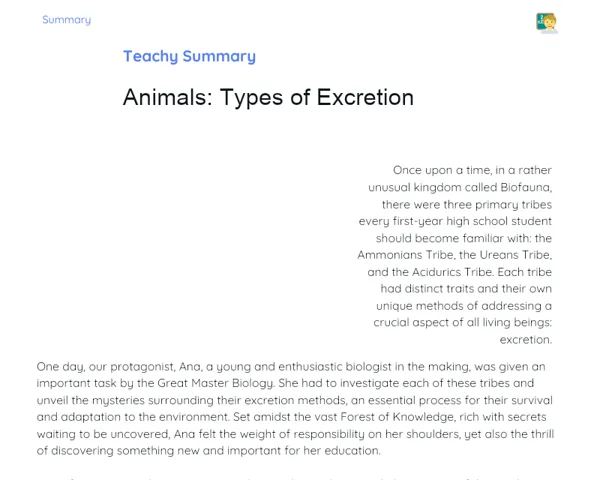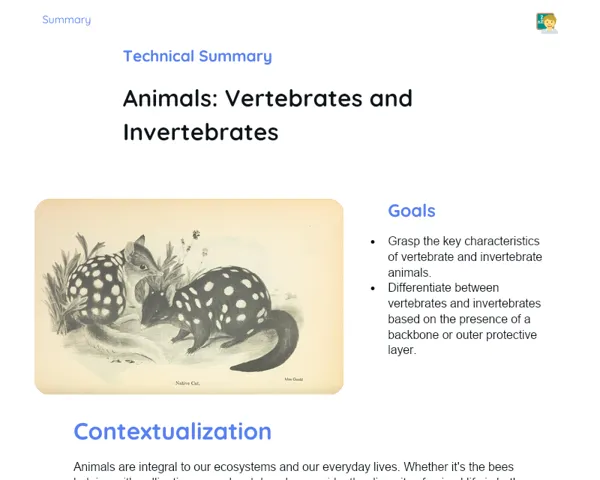Goals
1. Recognize the main types of animal excreta: ammonia, urea, and uric acid.
2. Identify which animal each type of excreta originates from.
3. Understand the significance of excretion in animal metabolism.
4. Connect excretion processes to how animals adapt to their surroundings.
Contextualization
To maintain balance in their bodies, animals need to efficiently excrete metabolic waste. Different species have evolved unique methods to dispose of harmful substances, such as ammonia, urea, and uric acid. These methods not only highlight the physiological traits of each species but also show how they are adapted to their specific environments. For instance, fish release ammonia directly into the water, where it disperses rapidly, lessening its toxicity. Mammals, on the other hand, convert ammonia into urea—less toxic and easily stored for later excretion. Birds and reptiles produce uric acid, which doesn’t dissolve in water, aiding in water conservation, especially in arid surroundings.
Subject Relevance
To Remember!
Ammonia
Ammonia is highly toxic waste produced from protein metabolism. It needs to be eliminated swiftly to prevent toxicity. This type of excretion is prevalent among aquatic animals, like fish, due to the abundance of water that helps dilute ammonia.
-
Highly toxic, requiring immediate excretion.
-
Commonly found in aquatic animals like fish.
-
Needs a considerable amount of water for proper dilution.
Urea
Urea is a less toxic form of waste compared to ammonia, synthesized in the liver of mammals through the urea cycle. It is soluble in water and can be stored in the body for a period before excretion, making it an efficient choice for land animals with limited water availability.
-
Less toxic than ammonia.
-
Produced in the liver via the urea cycle.
-
Common in mammals and other land-based animals.
Uric Acid
Uric acid is virtually insoluble in water, allowing for its excretion with minimal water loss. This method of excretion is typical in birds and reptiles that often live in environments where conserving water is essential. Uric acid is expelled as a white paste, efficiently conserving bodily fluids.
-
Almost insoluble in water.
-
Enables excretion with minimal water loss.
-
Typically found in birds and reptiles.
Practical Applications
-
In veterinary practice, understanding the types of excretion is key to diagnosing and treating kidney and metabolic illnesses in various animal species.
-
In environmental studies, analysing excreta can help track the health of wildlife populations and the condition of ecosystems.
-
In research, models of excretion are used to delve into animal physiology and to create new treatments for metabolic disorders.
Key Terms
-
Ammonia: Highly toxic waste from protein metabolism, largely found in aquatic animals.
-
Urea: Less toxic, water-soluble waste produced in the liver of mammals via the urea cycle.
-
Uric Acid: Nearly insoluble in water, common in birds and reptiles, excreted while minimizing water loss.
Questions for Reflections
-
How does the excretion of varying types of metabolic waste relate to the way animals adapt to their natural habitats?
-
What are the ecological impacts of the excretion of ammonia, urea, and uric acid in different ecosystems?
-
How can insights into the types of excretion be applied in environmental conservation efforts and treatment of animal diseases?
Practical Challenge: Building Excretion Models
In this challenge, you will create models that represent the excretion processes of different animals using simple materials. This activity will help reinforce your understanding of how ammonia, urea, and uric acid are excreted by fish, mammals, and birds/reptiles, respectively.
Instructions
-
Form groups and select a type of excreta: ammonia, urea, or uric acid.
-
Collect necessary materials: plastic bottles, tubes, colored water (to simulate the excreta), coffee filters, sand, etc.
-
Construct a model demonstrating the excretion process of your chosen animal. For example, the ammonia group can create a model showing how fish excrete ammonia directly into the water.
-
Present your model to the class, explaining the animal's excretion process and its relevance to environmental adaptation.
-
Engage in the discussion about the differences and similarities among the models presented and how each type of excretion corresponds to evolutionary adaptations to the animal's environment.


